Pheochromocytoma: Symptoms, Effects, and Homeostatic Disturbance
VerifiedAdded on 2023/06/11
|7
|1354
|385
AI Summary
This article discusses the symptoms, effects, and homeostatic disturbance of pheochromocytoma, a tumor that originates from the adrenal gland. It explains how it affects the cardiovascular, respiratory, endocrine, gastrointestinal, and nervous systems. The article also covers the biochemical breakdown of catecholamines and how it is diagnosed.
Contribute Materials
Your contribution can guide someone’s learning journey. Share your
documents today.
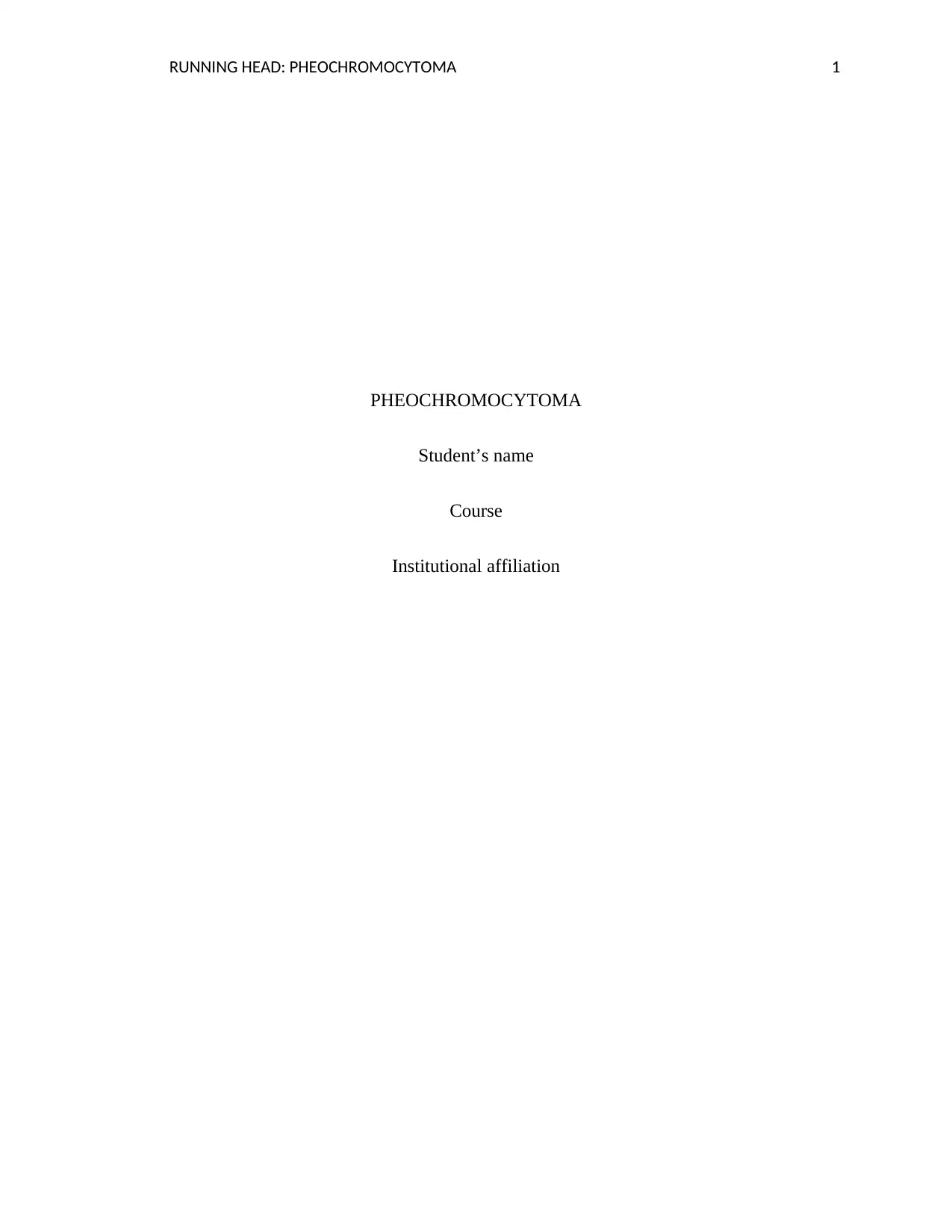
RUNNING HEAD: PHEOCHROMOCYTOMA 1
PHEOCHROMOCYTOMA
Student’s name
Course
Institutional affiliation
PHEOCHROMOCYTOMA
Student’s name
Course
Institutional affiliation
Secure Best Marks with AI Grader
Need help grading? Try our AI Grader for instant feedback on your assignments.
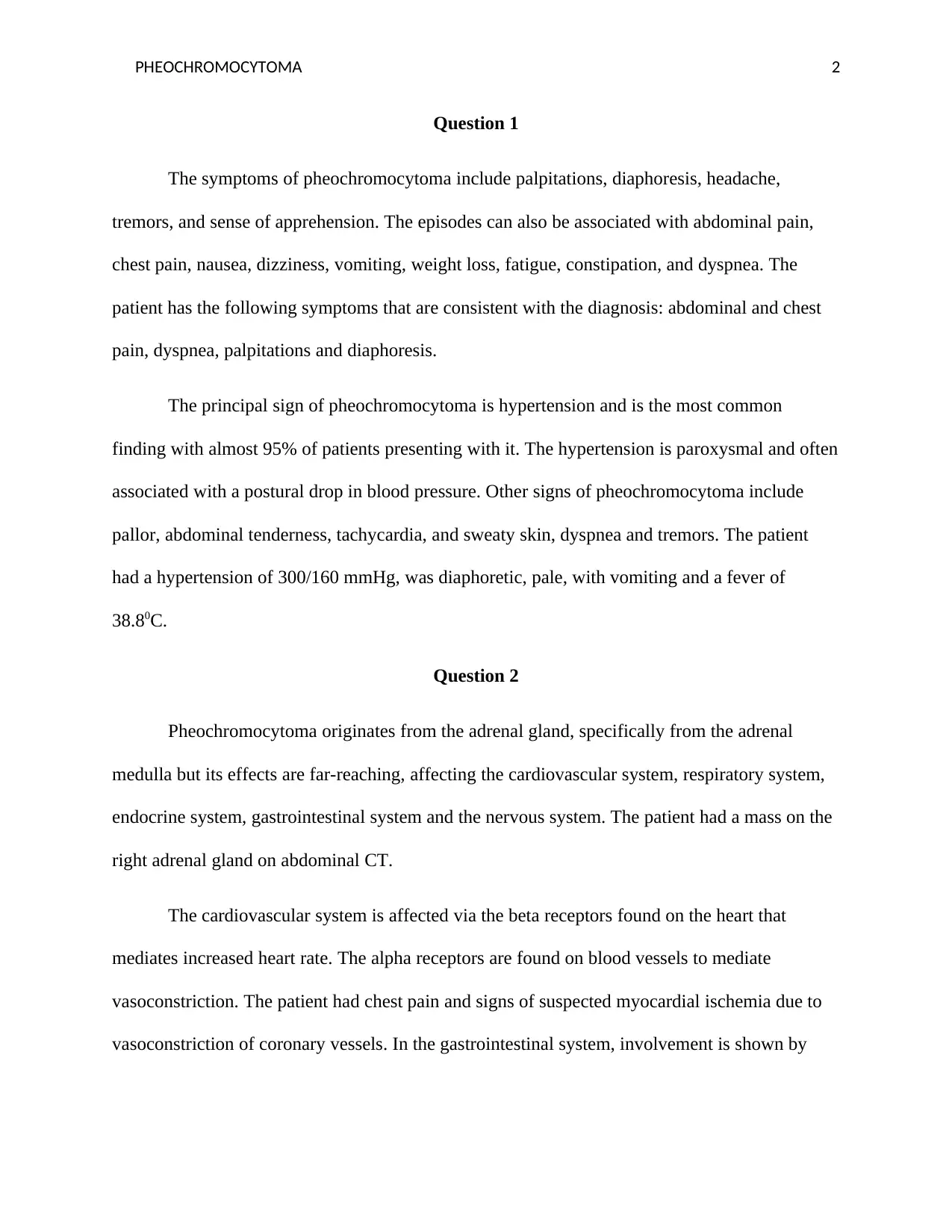
PHEOCHROMOCYTOMA 2
Question 1
The symptoms of pheochromocytoma include palpitations, diaphoresis, headache,
tremors, and sense of apprehension. The episodes can also be associated with abdominal pain,
chest pain, nausea, dizziness, vomiting, weight loss, fatigue, constipation, and dyspnea. The
patient has the following symptoms that are consistent with the diagnosis: abdominal and chest
pain, dyspnea, palpitations and diaphoresis.
The principal sign of pheochromocytoma is hypertension and is the most common
finding with almost 95% of patients presenting with it. The hypertension is paroxysmal and often
associated with a postural drop in blood pressure. Other signs of pheochromocytoma include
pallor, abdominal tenderness, tachycardia, and sweaty skin, dyspnea and tremors. The patient
had a hypertension of 300/160 mmHg, was diaphoretic, pale, with vomiting and a fever of
38.80C.
Question 2
Pheochromocytoma originates from the adrenal gland, specifically from the adrenal
medulla but its effects are far-reaching, affecting the cardiovascular system, respiratory system,
endocrine system, gastrointestinal system and the nervous system. The patient had a mass on the
right adrenal gland on abdominal CT.
The cardiovascular system is affected via the beta receptors found on the heart that
mediates increased heart rate. The alpha receptors are found on blood vessels to mediate
vasoconstriction. The patient had chest pain and signs of suspected myocardial ischemia due to
vasoconstriction of coronary vessels. In the gastrointestinal system, involvement is shown by
Question 1
The symptoms of pheochromocytoma include palpitations, diaphoresis, headache,
tremors, and sense of apprehension. The episodes can also be associated with abdominal pain,
chest pain, nausea, dizziness, vomiting, weight loss, fatigue, constipation, and dyspnea. The
patient has the following symptoms that are consistent with the diagnosis: abdominal and chest
pain, dyspnea, palpitations and diaphoresis.
The principal sign of pheochromocytoma is hypertension and is the most common
finding with almost 95% of patients presenting with it. The hypertension is paroxysmal and often
associated with a postural drop in blood pressure. Other signs of pheochromocytoma include
pallor, abdominal tenderness, tachycardia, and sweaty skin, dyspnea and tremors. The patient
had a hypertension of 300/160 mmHg, was diaphoretic, pale, with vomiting and a fever of
38.80C.
Question 2
Pheochromocytoma originates from the adrenal gland, specifically from the adrenal
medulla but its effects are far-reaching, affecting the cardiovascular system, respiratory system,
endocrine system, gastrointestinal system and the nervous system. The patient had a mass on the
right adrenal gland on abdominal CT.
The cardiovascular system is affected via the beta receptors found on the heart that
mediates increased heart rate. The alpha receptors are found on blood vessels to mediate
vasoconstriction. The patient had chest pain and signs of suspected myocardial ischemia due to
vasoconstriction of coronary vessels. In the gastrointestinal system, involvement is shown by

PHEOCHROMOCYTOMA 3
abdominal pain and vomiting in the patient. Metabolic effects lea to involvement of the skin as
seen by diaphoresis.
Question 3
This homeostatic disturbance is attributed to the tumor secreting large amounts of
catecholamines, epinephrine, and norepinephrine. The normal action of these catecholamines is
to mediate the flight or fright mechanism in response to stress such as physical, physiologic,
emotional and environmental. The pheochromocytoma will secrete these catecholamines in
excess and the homeostatic disturbance will be due to exaggerated effects of these hormones.
Catecholamines work through cell surface receptors and signal transduction to bring
about effects on the target organs. The receptors of catecholamines are termed adrenergic
receptors and are divided into alpha and beta receptors. They are further subdivided into α1, α2,
β1, and β2
α1 receptors are predominantly found on smooth muscles and mediate contraction when
stimulated including vasoconstriction. In excess stimulation like in. pheochromocytoma, action
on smooth muscle on blood vessel walls will lead to vasoconstriction, reduced peripheral
resistance that translates to increased systemic blood pressure. This can be shown in the case
study as the patient had a hypertension of 300/160. The vasoconstriction will also lead to
reduction multiple organ perfusion and hypoxia with the risk of hypoxic and ischemic damage.
This is the reason for chest pain and suspected myocardial infarction noted by ST depression on
the patient electrocardiograph.
abdominal pain and vomiting in the patient. Metabolic effects lea to involvement of the skin as
seen by diaphoresis.
Question 3
This homeostatic disturbance is attributed to the tumor secreting large amounts of
catecholamines, epinephrine, and norepinephrine. The normal action of these catecholamines is
to mediate the flight or fright mechanism in response to stress such as physical, physiologic,
emotional and environmental. The pheochromocytoma will secrete these catecholamines in
excess and the homeostatic disturbance will be due to exaggerated effects of these hormones.
Catecholamines work through cell surface receptors and signal transduction to bring
about effects on the target organs. The receptors of catecholamines are termed adrenergic
receptors and are divided into alpha and beta receptors. They are further subdivided into α1, α2,
β1, and β2
α1 receptors are predominantly found on smooth muscles and mediate contraction when
stimulated including vasoconstriction. In excess stimulation like in. pheochromocytoma, action
on smooth muscle on blood vessel walls will lead to vasoconstriction, reduced peripheral
resistance that translates to increased systemic blood pressure. This can be shown in the case
study as the patient had a hypertension of 300/160. The vasoconstriction will also lead to
reduction multiple organ perfusion and hypoxia with the risk of hypoxic and ischemic damage.
This is the reason for chest pain and suspected myocardial infarction noted by ST depression on
the patient electrocardiograph.
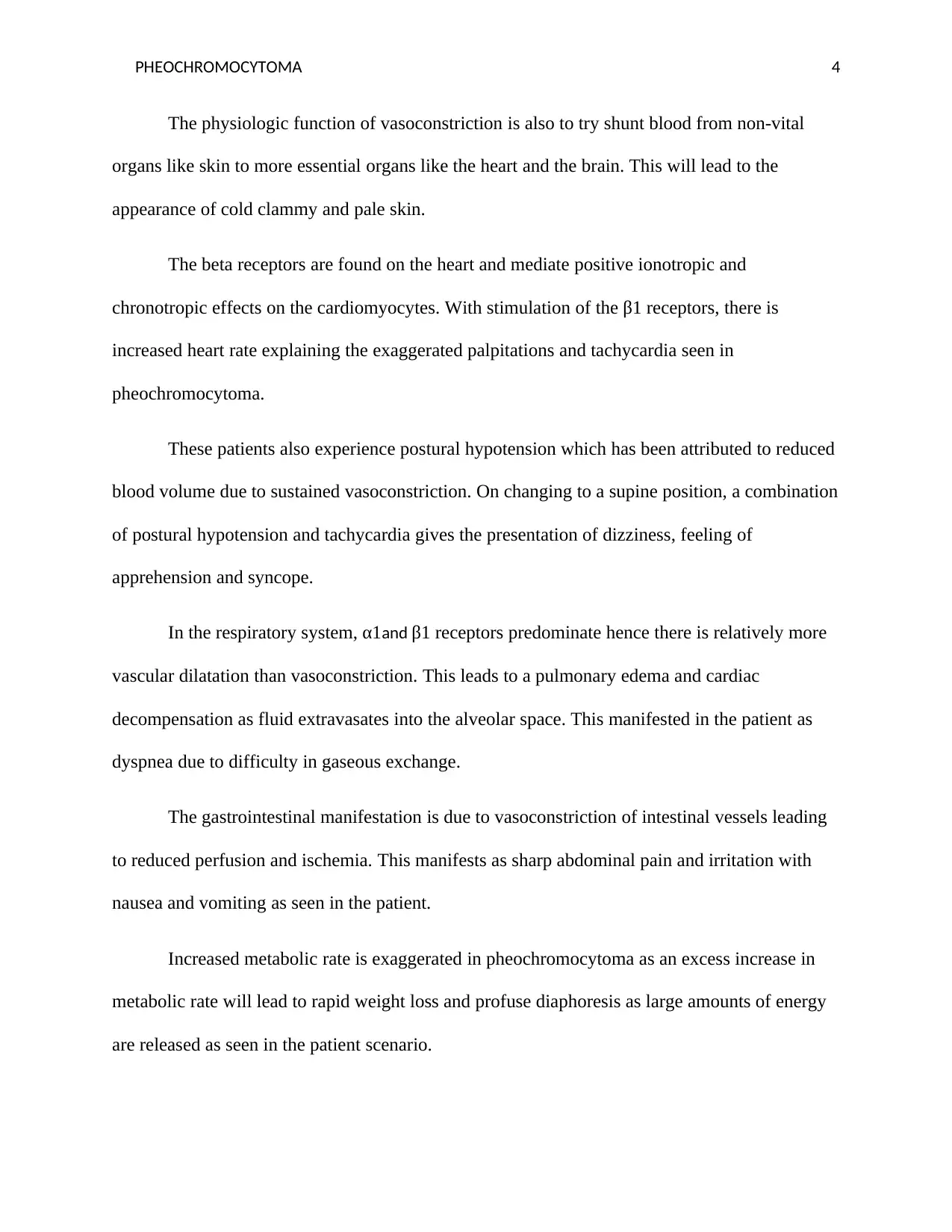
PHEOCHROMOCYTOMA 4
The physiologic function of vasoconstriction is also to try shunt blood from non-vital
organs like skin to more essential organs like the heart and the brain. This will lead to the
appearance of cold clammy and pale skin.
The beta receptors are found on the heart and mediate positive ionotropic and
chronotropic effects on the cardiomyocytes. With stimulation of the β1 receptors, there is
increased heart rate explaining the exaggerated palpitations and tachycardia seen in
pheochromocytoma.
These patients also experience postural hypotension which has been attributed to reduced
blood volume due to sustained vasoconstriction. On changing to a supine position, a combination
of postural hypotension and tachycardia gives the presentation of dizziness, feeling of
apprehension and syncope.
In the respiratory system, α1and β1 receptors predominate hence there is relatively more
vascular dilatation than vasoconstriction. This leads to a pulmonary edema and cardiac
decompensation as fluid extravasates into the alveolar space. This manifested in the patient as
dyspnea due to difficulty in gaseous exchange.
The gastrointestinal manifestation is due to vasoconstriction of intestinal vessels leading
to reduced perfusion and ischemia. This manifests as sharp abdominal pain and irritation with
nausea and vomiting as seen in the patient.
Increased metabolic rate is exaggerated in pheochromocytoma as an excess increase in
metabolic rate will lead to rapid weight loss and profuse diaphoresis as large amounts of energy
are released as seen in the patient scenario.
The physiologic function of vasoconstriction is also to try shunt blood from non-vital
organs like skin to more essential organs like the heart and the brain. This will lead to the
appearance of cold clammy and pale skin.
The beta receptors are found on the heart and mediate positive ionotropic and
chronotropic effects on the cardiomyocytes. With stimulation of the β1 receptors, there is
increased heart rate explaining the exaggerated palpitations and tachycardia seen in
pheochromocytoma.
These patients also experience postural hypotension which has been attributed to reduced
blood volume due to sustained vasoconstriction. On changing to a supine position, a combination
of postural hypotension and tachycardia gives the presentation of dizziness, feeling of
apprehension and syncope.
In the respiratory system, α1and β1 receptors predominate hence there is relatively more
vascular dilatation than vasoconstriction. This leads to a pulmonary edema and cardiac
decompensation as fluid extravasates into the alveolar space. This manifested in the patient as
dyspnea due to difficulty in gaseous exchange.
The gastrointestinal manifestation is due to vasoconstriction of intestinal vessels leading
to reduced perfusion and ischemia. This manifests as sharp abdominal pain and irritation with
nausea and vomiting as seen in the patient.
Increased metabolic rate is exaggerated in pheochromocytoma as an excess increase in
metabolic rate will lead to rapid weight loss and profuse diaphoresis as large amounts of energy
are released as seen in the patient scenario.
Secure Best Marks with AI Grader
Need help grading? Try our AI Grader for instant feedback on your assignments.
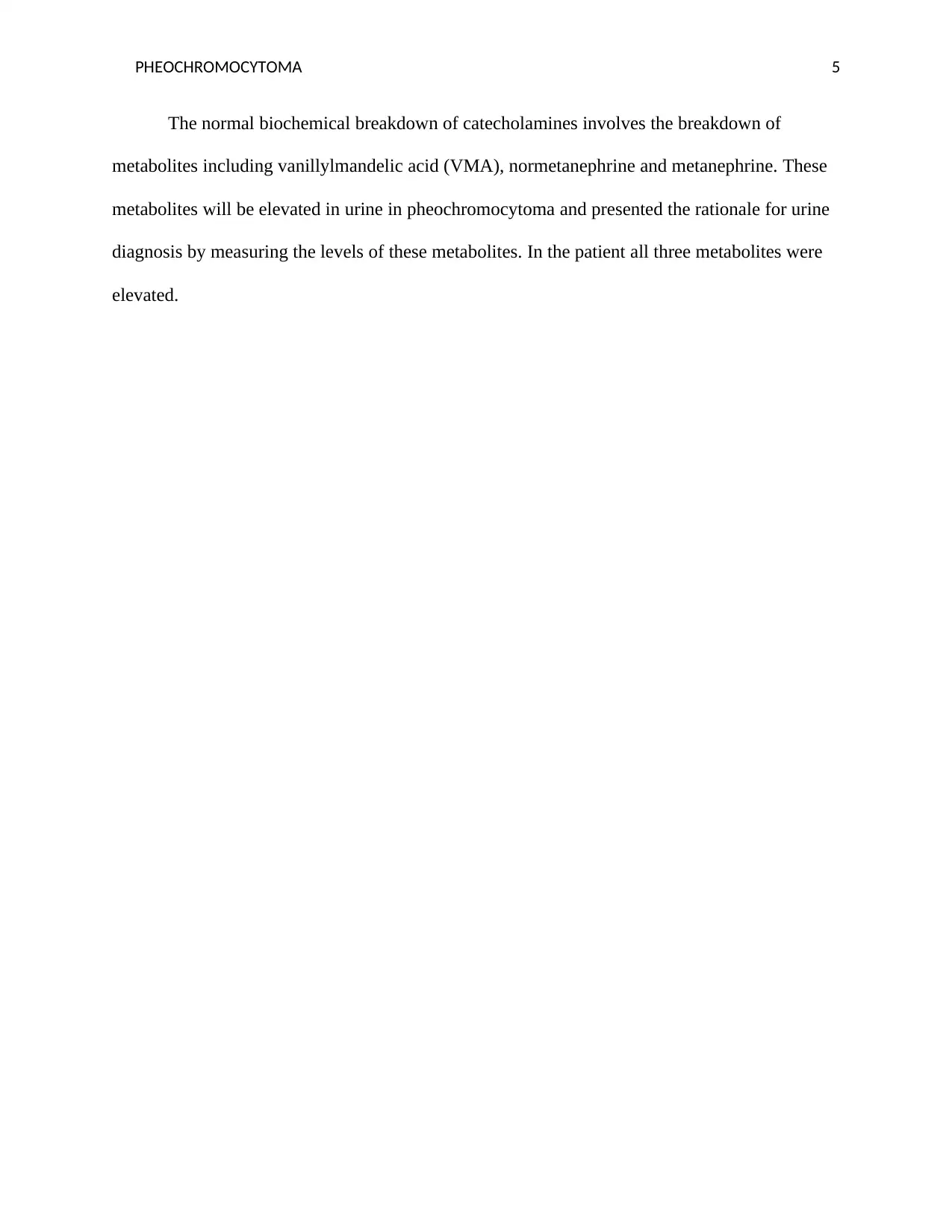
PHEOCHROMOCYTOMA 5
The normal biochemical breakdown of catecholamines involves the breakdown of
metabolites including vanillylmandelic acid (VMA), normetanephrine and metanephrine. These
metabolites will be elevated in urine in pheochromocytoma and presented the rationale for urine
diagnosis by measuring the levels of these metabolites. In the patient all three metabolites were
elevated.
The normal biochemical breakdown of catecholamines involves the breakdown of
metabolites including vanillylmandelic acid (VMA), normetanephrine and metanephrine. These
metabolites will be elevated in urine in pheochromocytoma and presented the rationale for urine
diagnosis by measuring the levels of these metabolites. In the patient all three metabolites were
elevated.

PHEOCHROMOCYTOMA 6
References
Adler, J. T., Meyer-Rochow, G. Y., Chen, H., Benn, D. E., Robinson, B. G., Sippel, R. S., &
Sidhu, S. B. 2008, ‘Pheochromocytoma: current approaches and future directions’, The
oncologist, 13(7), pp.779-793.
Barrett, K. E., Barman, S. M., Boitano, S., & Brooks, H. 2009,’Ganong’s review of medical
physiology’, pp. 23. NY: McGraw-Hill Medical.
Benn, D. E., Gimenez-Roqueplo, A. P., Reilly, J. R., Bertherat, J., Burgess, J., Byth, K., ... &
Henley, D. 2006, ‘Clinical presentation and penetrance of
pheochromocytoma/paraganglioma syndromes’, The Journal of Clinical Endocrinology
& Metabolism, 91(3), pp. 827-836.
Hein, L. 2006, ‘Adrenoceptors and signal transduction in neurons’, Cell and tissue
research, 326(2), pp. 541-551
Pacak, K. 2007, ‘Preoperative management of the pheochromocytoma patient’, The Journal of
Clinical Endocrinology & Metabolism, 92(11), pp. 4069-4079.
Pacak, K., Eisenhofer, G., Ahlman, H., Bornstein, S. R., Gimenez-Roqueplo, A. P., Grossman,
A. B., ... & Tischler, A. S. 2007, ‘Pheochromocytoma: recommendations for clinical
practice from the First International Symposium’, Nature Reviews Endocrinology, 3(2),
pp. 92.
Reisch, N., Peczkowska, M., Januszewicz, A., & Neumann, H. P. 2006,’Pheochromocytoma:
presentation, diagnosis, and treatment’, Journal of hypertension, 24(12), pp. 2331-2339.
References
Adler, J. T., Meyer-Rochow, G. Y., Chen, H., Benn, D. E., Robinson, B. G., Sippel, R. S., &
Sidhu, S. B. 2008, ‘Pheochromocytoma: current approaches and future directions’, The
oncologist, 13(7), pp.779-793.
Barrett, K. E., Barman, S. M., Boitano, S., & Brooks, H. 2009,’Ganong’s review of medical
physiology’, pp. 23. NY: McGraw-Hill Medical.
Benn, D. E., Gimenez-Roqueplo, A. P., Reilly, J. R., Bertherat, J., Burgess, J., Byth, K., ... &
Henley, D. 2006, ‘Clinical presentation and penetrance of
pheochromocytoma/paraganglioma syndromes’, The Journal of Clinical Endocrinology
& Metabolism, 91(3), pp. 827-836.
Hein, L. 2006, ‘Adrenoceptors and signal transduction in neurons’, Cell and tissue
research, 326(2), pp. 541-551
Pacak, K. 2007, ‘Preoperative management of the pheochromocytoma patient’, The Journal of
Clinical Endocrinology & Metabolism, 92(11), pp. 4069-4079.
Pacak, K., Eisenhofer, G., Ahlman, H., Bornstein, S. R., Gimenez-Roqueplo, A. P., Grossman,
A. B., ... & Tischler, A. S. 2007, ‘Pheochromocytoma: recommendations for clinical
practice from the First International Symposium’, Nature Reviews Endocrinology, 3(2),
pp. 92.
Reisch, N., Peczkowska, M., Januszewicz, A., & Neumann, H. P. 2006,’Pheochromocytoma:
presentation, diagnosis, and treatment’, Journal of hypertension, 24(12), pp. 2331-2339.
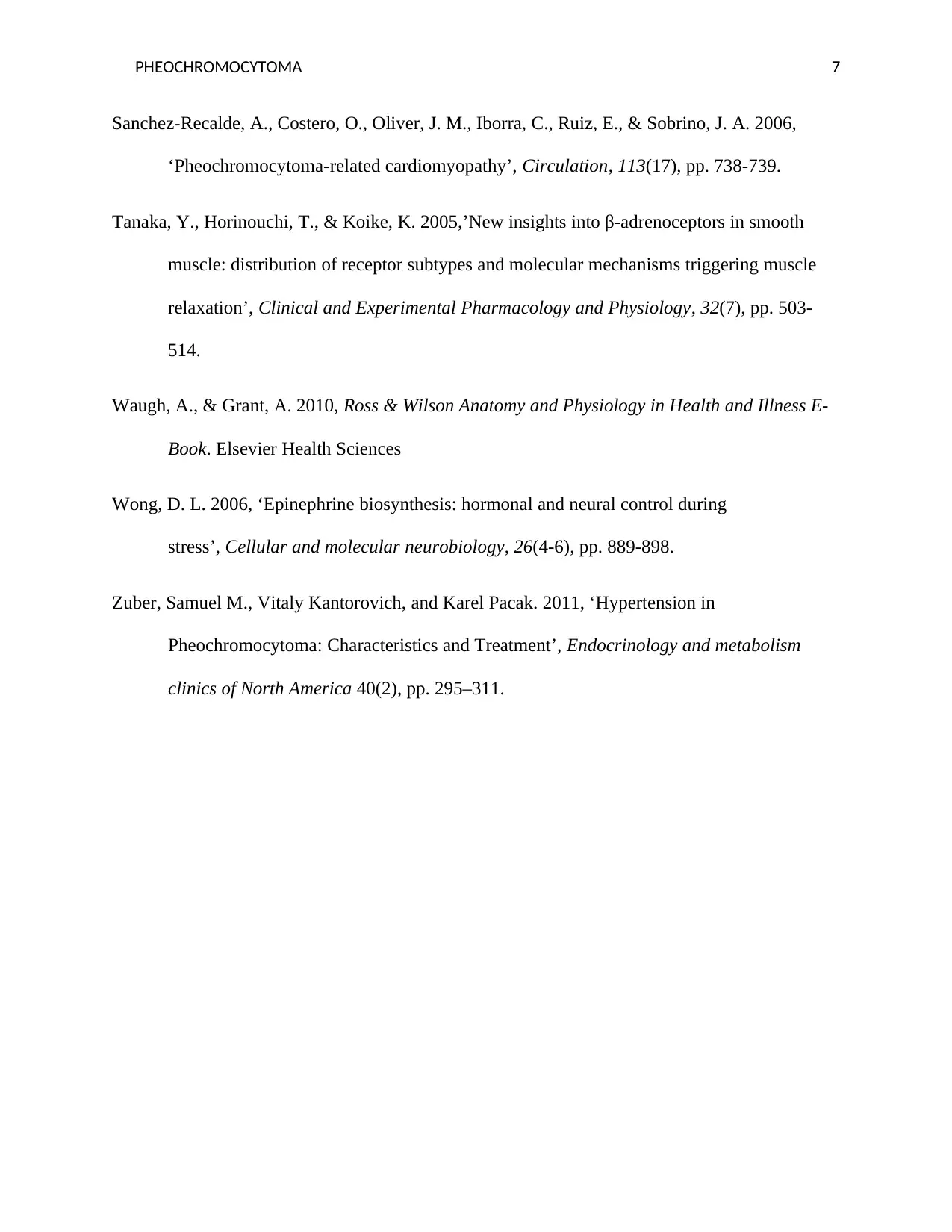
PHEOCHROMOCYTOMA 7
Sanchez-Recalde, A., Costero, O., Oliver, J. M., Iborra, C., Ruiz, E., & Sobrino, J. A. 2006,
‘Pheochromocytoma-related cardiomyopathy’, Circulation, 113(17), pp. 738-739.
Tanaka, Y., Horinouchi, T., & Koike, K. 2005,’New insights into β‐adrenoceptors in smooth
muscle: distribution of receptor subtypes and molecular mechanisms triggering muscle
relaxation’, Clinical and Experimental Pharmacology and Physiology, 32(7), pp. 503-
514.
Waugh, A., & Grant, A. 2010, Ross & Wilson Anatomy and Physiology in Health and Illness E-
Book. Elsevier Health Sciences
Wong, D. L. 2006, ‘Epinephrine biosynthesis: hormonal and neural control during
stress’, Cellular and molecular neurobiology, 26(4-6), pp. 889-898.
Zuber, Samuel M., Vitaly Kantorovich, and Karel Pacak. 2011, ‘Hypertension in
Pheochromocytoma: Characteristics and Treatment’, Endocrinology and metabolism
clinics of North America 40(2), pp. 295–311.
Sanchez-Recalde, A., Costero, O., Oliver, J. M., Iborra, C., Ruiz, E., & Sobrino, J. A. 2006,
‘Pheochromocytoma-related cardiomyopathy’, Circulation, 113(17), pp. 738-739.
Tanaka, Y., Horinouchi, T., & Koike, K. 2005,’New insights into β‐adrenoceptors in smooth
muscle: distribution of receptor subtypes and molecular mechanisms triggering muscle
relaxation’, Clinical and Experimental Pharmacology and Physiology, 32(7), pp. 503-
514.
Waugh, A., & Grant, A. 2010, Ross & Wilson Anatomy and Physiology in Health and Illness E-
Book. Elsevier Health Sciences
Wong, D. L. 2006, ‘Epinephrine biosynthesis: hormonal and neural control during
stress’, Cellular and molecular neurobiology, 26(4-6), pp. 889-898.
Zuber, Samuel M., Vitaly Kantorovich, and Karel Pacak. 2011, ‘Hypertension in
Pheochromocytoma: Characteristics and Treatment’, Endocrinology and metabolism
clinics of North America 40(2), pp. 295–311.
1 out of 7
Your All-in-One AI-Powered Toolkit for Academic Success.
+13062052269
info@desklib.com
Available 24*7 on WhatsApp / Email
![[object Object]](/_next/static/media/star-bottom.7253800d.svg)
Unlock your academic potential
© 2024 | Zucol Services PVT LTD | All rights reserved.